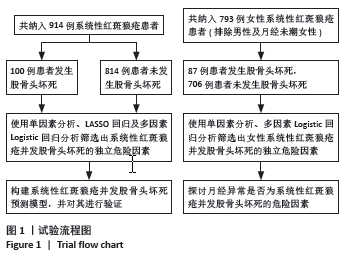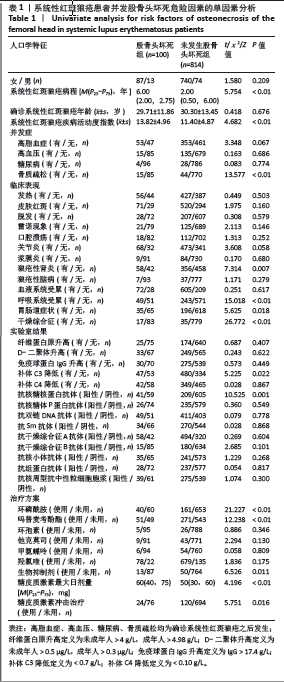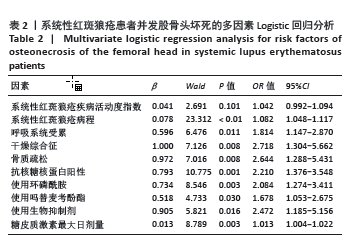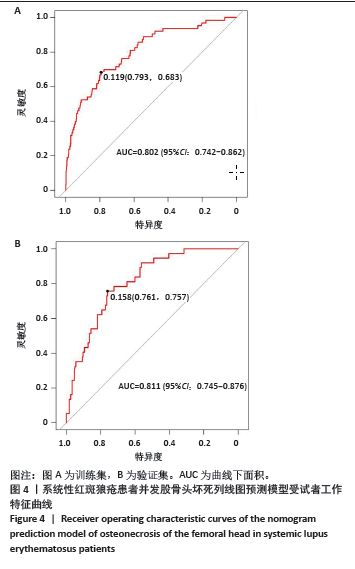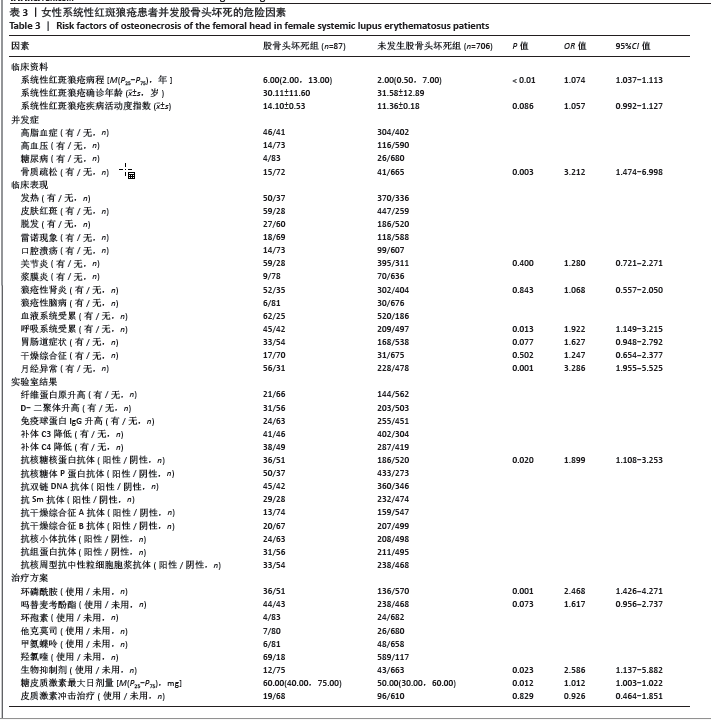[1] KIRIAKIDOU M, CHING CL. Systemic Lupus Erythematosus. Ann Intern Med. 2020;172(11):Itc81-Itc96.
[2] KANEKO K, CHEN H, KAUFMAN M, et al. Glucocorticoid-induced osteonecrosis in systemic lupus erythematosus patients. Clin Transl Med. 2021;11(10):e526.
[3] ERSIN M, DEMIREL M, EKINCI M, et al. Symptomatic osteonecrosis of the hip and knee in patients with systemic lupus erythematosus: Prevalence, pattern, and comparison of natural course. Lupus. 2021; 30(10):1603-1608.
[4] ZHAO D, ZHANG F, WANG B, et al. Guidelines for clinical diagnosis and treatment of osteonecrosis of the femoral head in adults (2019 version). J Orthop Translat. 2020;21:100-110.
[5] TRENT S, SICAT CS, SLOVER J. Femoral Head Osteonecrosis in Systemic Lupus Erythematosus: Total Hip Arthroplasty Outcomes and Considerations. JBJS Rev. 2021;9(4). doi: 10.2106/JBJS.RVW. 20.00142.
[6] CALVO-ALÉN J, MCGWIN G, TOLOZA S, et al. Systemic lupus erythematosus in a multiethnic US cohort (LUMINA): XXIV. Cytotoxic treatment is an additional risk factor for the development of symptomatic osteonecrosis in lupus patients: results of a nested matched case-control study. Ann Rheum Dis. 2006;65(6):785-790.
[7] OINUMA K, HARADA Y, NAWATA Y, et al. Osteonecrosis in patients with systemic lupus erythematosus develops very early after starting high dose corticosteroid treatment. Ann Rheum Dis. 2001;60(12): 1145-1148.
[8] 许砚钧, 陈圣宝, 蔡倩莹, 等. 系统性红斑狼疮激素暴露患者发生股骨头坏死情况及临床特征分析:一项基于前瞻性队列的描述性研究[J]. 中国修复重建外科杂志,2023,37(5):605-614.
[9] HISADA R, KATO M, OHNISHI N, et al. Antiphospholipid score is a novel risk factor for idiopathic osteonecrosis of the femoral head in patients with systemic lupus erythematosus. Rheumatology (Oxford). 2019;58(4):645-649.
[10] KURODA T, TANABE N, WAKAMATSU A, et al. High triglyceride is a risk factor for silent osteonecrosis of the femoral head in systemic lupus erythematosus. Clin Rheumatol. 2015;34(12):2071-2077.
[11] HUSSEIN S, SUITNER M, BéLAND-BONENFANT S, et al. Monitoring of Osteonecrosis in Systemic Lupus Erythematosus: A Systematic Review and Metaanalysis. J Rheumatol. 2018; 45(10):1462-1476.
[12] SUETSUGU H, KIM K, YAMAMOTO T, et al. Novel susceptibility loci for steroid-associated osteonecrosis of the femoral head in systemic lupus erythematosus. Hum Mol Genet. 2022;31(7):1082-1095.
[13] WEBBER D, CAO J, DOMINGUEZ D, et al. Genetics of osteonecrosis in children and adults with systemic lupus erythematosus. Rheumatology (Oxford). 2023;62(9):3205-3212.
[14] TIAN J, ZHANG D, YAO X, et al. Global epidemiology of systemic lupus erythematosus: a comprehensive systematic analysis and modelling study. Ann Rheum Dis. 2023;82(3):351-356.
[15] HOU Y, JIN J, LUO L, et al. Menstrual irregularity, pregnancy outcomes, and birth outcomes in patients with systemic lupus erythematosus of childbearing age in China: a multicenter cross-sectional study. Chin Med J (Engl). 2023;136(23):2886-2888.
[16] MORALES-MARTíNEZ FA, SALAS-CASTRO C, GARCíA-GARZA MR, et al. Evaluation of the Ovarian Reserve in Women With Systemic Lupus Erythematosus. J Family Reprod Health. 2021;15(1):38-44.
[17] GIAMBALVO S, GARAFFONI C, SILVAGNI E, et al. Factors associated with fertility abnormalities in women with systemic lupus erythematosus: a systematic review and meta-analysis. Autoimmun Rev. 2022;21(4): 103038.
[18] ARINGER M, COSTENBADER K, DAIKH D, et al. 2019 European League Against Rheumatism/American College of Rheumatology classification criteria for systemic lupus erythematosus. Ann Rheum Dis. 2019;78(9):1151-1159.
[19] KIM J, LEE SK, KIM JY, et al. CT and MRI findings beyond the subchondral bone in osteonecrosis of the femoral head to distinguish between ARCO stages 2 and 3A. Eur Radiol. 2023;33(7):4789-800.
[20] 中国医师协会骨科医师分会骨循环与骨坏死专业委员会,中华医学会骨科分会骨显微修复学组,国际骨循环学会中国区. 中国成人股骨头坏死临床诊疗指南(2020)[J]. 中华骨科杂志,2020, 40(20):1365-1376.
[21] DI MATTEO A, SMERILLI G, CIPOLLETTA E, et al. Imaging of Joint and Soft Tissue Involvement in Systemic Lupus Erythematosus. Curr Rheumatol Rep. 2021;23(9):73.
[22] 中华医学会妇产科学分会妇科内分泌学组. 异常子宫出血诊断与治疗指南(2022更新版)[J]. 中华妇产科杂志,2022,57(7):481-490.
[23] 沈南,赵毅,段利华,等.系统性红斑狼疮诊疗规范[J]. 中华内科杂志,2023,62(7):775-784.
[24] CHEN S, CAI Q, XU Y, et al. Associations between glucocorticoids, antiphospholipid antibodies and femur head necrosis in patients with SLE: a directed acyclic graph-based multicentre study. Ther Adv Musculoskelet Dis. 2021;13:1759720x211002677.
[25] 韩俊杰, 武迪, 陈志胜, 等. 2型糖尿病患者并发糖尿病肾病风险的列线图预测模型与验证研究[J]. 中国全科医学,2024,27(9):1054-1061.
[26] HARDY RS, RAZA K, COOPER MS. Therapeutic glucocorticoids: mechanisms of actions in rheumatic diseases. Nat Rev Rheumatol. 2020;16(3):133-144.
[27] HUANG C, WEN Z, NIU J, et al. Steroid-Induced Osteonecrosis of the Femoral Head: Novel Insight Into the Roles of Bone Endothelial Cells in Pathogenesis and Treatment. Front Cell Dev Biol. 2021;9:777697.
[28] MOTTA F, TIMILSINA S, GERSHWIN ME, et al. Steroid-induced osteonecrosis. J Transl Autoimmun. 2022;5:100168.
[29] KALLAS R, LI J, PETRI M. Predictors of Osteonecrosis in Systemic Lupus Erythematosus: A Prospective Cohort Study. Arthritis Care Res (Hoboken). 2022;74(7):1122-1132.
[30] CHENG C, HUANG C, CHEN Z, et al. Risk factors for avascular necrosis in patients with systemic lupus erythematosus: a multi-center cohort study of Chinese SLE Treatment and Research Group (CSTAR) Registry XXII. Arthritis Res Ther. 2023;25(1):78.
[31] ZHAO D, WANG C, ZHAO Y, et al. Cyclophosphamide causes osteoporosis in C57BL/6 male mice: suppressive effects of cyclophosphamide on osteoblastogenesis and osteoclastogenesis. Oncotarget. 2017;8(58): 98163-98183.
[32] FAEZI ST, HOSEINIAN AS, PARAGOMI P, et al. Non-corticosteroid risk factors of symptomatic avascular necrosis of bone in systemic lupus erythematosus: A retrospective case-control study. Mod Rheumatol. 2015;25(4):590-594.
[33] LEE J, KWOK SK, JUNG SM, et al. Osteonecrosis of the hip in Korean patients with systemic lupus erythematosus: risk factors and clinical outcome. Lupus. 2014;23(1):39-45.
[34] FANOURIAKIS A, KOSTOPOULOU M, ALUNNO A, et al. 2019 update of the EULAR recommendations for the management of systemic lupus erythematosus. Ann Rheum Dis. 2019;78(6):736-745.
[35] NAWATA K, NAKAMURA J, IKEDA K, et al. Transitional changes in the incidence of osteonecrosis in systemic lupus erythematosus patients: focus on immunosuppressant agents and glucocorticoids. Rheumatology (Oxford). 2018;57(5):844-849.
[36] MA J, GE J, GAO F, et al. The Role of Immune Regulatory Cells in Nontraumatic Osteonecrosis of the Femoral Head: A Retrospective Clinical Study. Biomed Res Int. 2019;2019:1302015.
[37] 蔡李骏,王秋入,陈长军,等. 免疫细胞调节股骨头坏死发生发展的研究进展[J]. 中国修复重建外科杂志,2022,36(11):1428-1433.
[38] ZHANG H, XIAO F, LIU Y, et al. A higher frequency of peripheral blood activated B cells in patients with non-traumatic osteonecrosis of the femoral head. Int Immunopharmacol. 2014;20(1):95-100.
[39] GHOBADINEZHAD F, EBRAHIMI N, MOZAFFARI F, et al. The emerging role of regulatory cell-based therapy in autoimmune disease. Front Immunol. 2022;13:1075813.
[40] FASANO S, MILONE A, NICOLETTI GF, et al. Precision medicine in systemic lupus erythematosus. Nat Rev Rheumatol. 2023;19(6):331-342.
[41] CHENG H, ZHANG XY, YANG HD, et al. Efficacy and safety of belimumab/low-dose cyclophosphamide therapy in moderate-to-severe systemic lupus erythematosus. Front Immunol. 2022;13:911730.
[42] 陈明, 林进, 曹恒. 生物靶向治疗药物在狼疮性肾炎中的研究进展[J]. 中国新药杂志,2023,32(22):2225-2233.
[43] FANOURIAKIS A, KOSTOPOULOU M, ANDERSEN J, et al. EULAR recommendations for the management of systemic lupus erythematosus: 2023 update. Ann Rheum Dis. 2024;83(1):15-29.
[44] MOGHAZY AA, IBRAHIM AM. Predictors of Avascular Necrosis in a Cohort of Egyptian Systemic Lupus Erythematosus Patients: Retrospective Two Centers Study. Curr Rheumatol Rev. 2022;18(2): 144-149.
[45] TSELIOS K, GLADMAN DD, TOUMA Z, et al. Disease course patterns in systemic lupus erythematosus. Lupus. 2019;28(1):114-122.
[46] 孔芳,李小霞,赵义. 系统性红斑狼疮并发股骨头坏死或膝关节骨梗死的临床特点分析[J]. 中国医师杂志,2020,22(5):766-770.
[47] LONG Y, ZHANG S, ZHAO J, et al. Risk of osteonecrosis in systemic lupus erythematosus: An 11-year Chinese single-center cohort study. Lupus. 2021;30(9):1459-1468.
[48] 张嵩,谢长好,陈琳洁.女性系统性红斑狼疮合并膝关节骨梗死的临床分析[J].中华全科医学,2020,18(7):1103-1106.
[49] DE MEDEIROS SF, RODGERS RJ, NORMAN RJ. Adipocyte and steroidogenic cell cross-talk in polycystic ovary syndrome. Hum Reprod Update. 2021;27(4):771-796.
[50] SHARMA SK, JAIN S, BAHL P, et al. Ovarian dysfunction with moderate-dose intravenous cyclophosphamide (modified NIH regimen) and mycophenolate mofetil in young adults with severe lupus: a prospective cohort study. Arthritis Res Ther. 2020;22(1):189.
[51] WANG P, WANG C, MENG H, et al. The Role of Structural Deterioration and Biomechanical Changes of the Necrotic Lesion in Collapse Mechanism of Osteonecrosis of the Femoral Head. Orthop Surg. 2022; 14(5):831-839.
[52] ONO T, HAYASHI M, SASAKI F, et al. RANKL biology: bone metabolism, the immune system, and beyond. Inflamm Regen. 2020;40:2.
[53] ADAMI G, FASSIO A, ROSSINI M, et al. Osteoporosis in Rheumatic Diseases. Int J Mol Sci. 2019;20(23):5867.
[54] LEE DSW, ROJAS OL, GOMMERMAN JL. B cell depletion therapies in autoimmune disease: advances and mechanistic insights. Nat Rev Drug Discov. 2021;20(3):179-199.
[55] WANG X, YAN S, LIU C, et al. Fracture risk and bone mineral density levels in patients with systemic lupus erythematosus: a systematic review and meta-analysis. Osteoporos Int. 2016;27(4):1413-1423.
[56] 徐玉德, 李盛华, 周明旺, 等. 基于通络法探讨骨质疏松症与微循环障碍的相关性[J]. 中国骨质疏松杂志,2020,26(5):760-762.
[57] 李宁宁,陈奕均,冷晓梅,等. 系统性红斑狼疮并发骨坏死118例临床特点及危险因素分析[J]. 中华内科杂志,2021,60(8):744-750.
[58] 郭娟, 周惠琼, 张清, 等. 系统性红斑狼疮合并骨坏死的临床特点及骨密度结果分析[J]. 中国骨质疏松杂志,2020,26(3):403-406+411.
[59] RAMOS-CASALS M, BRITO-ZERÓN P, BOMBARDIERI S, et al. EULAR recommendations for the management of Sjögren’s syndrome with topical and systemic therapies. Ann Rheum Dis. 2020;79(1):3-18.
[60] 姜泉, 周新尧, 唐晓颇, 等. 干燥综合征病证结合诊疗指南[J]. 中医杂志,2024,65(4):434-444.
[61] SIEIRO SANTOS C, MORIANO MORALES C, ÁLVAREZ CASTRO C, et al. Polyautoimmunity in systemic lupus erythematosus: secondary Sjogren syndrome. Z Rheumatol. 2023;82(Suppl 1):68-73.
[62] NEVSKAYA T, GAMBLE MP, POPE JE. A meta-analysis of avascular necrosis in systemic lupus erythematosus: prevalence and risk factors. Clin Exp Rheumatol. 2017;35(4):700-710.
[63] SAYARLIOGLU M, YUZBASIOGLU N, INANC M, et al. Risk factors for avascular bone necrosis in patients with systemic lupus erythematosus. Rheumatol Int. 2012;32(1):177-182.
[64] 刘岩, 黄婧, 杨路路, 等. 不同疾病活动度系统性红斑狼疮患者血清补体C3、C4、ESR、IL-6及自身抗体的相关性分析[J]. 河北医药, 2023,45(10):1500-1503.
[65] CHEBBI PP, GOEL R, RAMYA J, et al. Nailfold capillaroscopy changes associated with anti-RNP antibodies in systemic lupus erythematosus. Rheumatol Int. 2022;42(8):1355-1361.
[66] LEE BW, KWON EJ, PARK Y, et al. Predictors for future development of systemic lupus erythematosus in Korean Sjögren’s syndrome patients. Lupus. 2023;32(12):1359-1368.
[67] LUN X, YANG J, LIU Y, et al. Risk factors of systemic lupus erythematosus patients with pulmonary arterial hypertension: A systematic review and meta-analysis. Medicine. 2023;102(51):e36654.
[68] XIONG J, WANG G, XU T, et al. Anti-RNP Antibody: A Potential Novel Predictor for Osteonecrosis in Systemic Lupus Erythematosus. Front Med (Lausanne). 2022;9:847875.
[69] MATSUEDA Y, ARINUMA Y, NAGAI T, et al. Synergistic enhancement of production of proinflammatory cytokines of human peripheral blood monocytes by anti-Sm and anti-RNP antibodies. PloS One. 2018;13(12): e0209282. |
